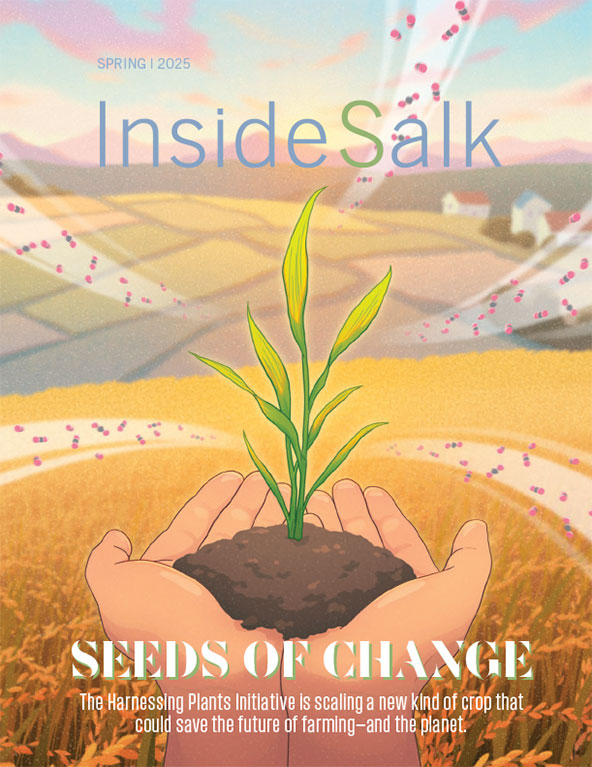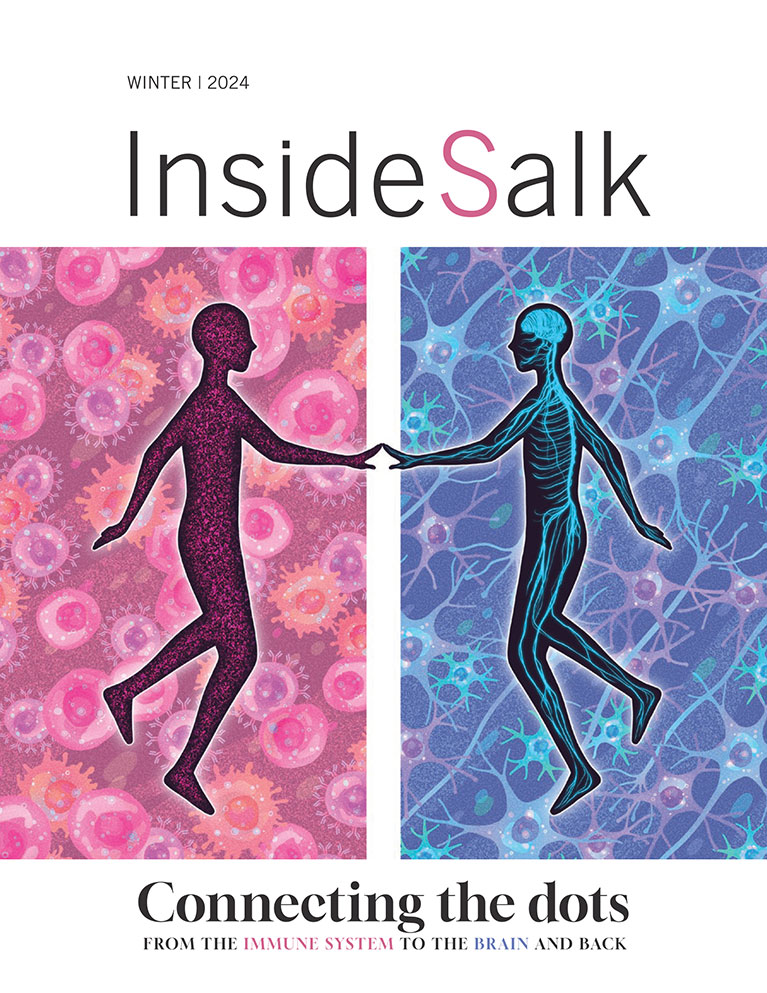Salk faculty Joseph Ecker, Margarita Behrens and colleagues analyzed over 100,000 mouse brain cells using a scientific technique that identifies a chemical pattern called methylation, which is one way cells control gene expression. The scientists then applied this technique to thousands of cells from 45 different regions of the mouse brain and identified 161 clusters of cell types, each distinguished by its pattern of methylation. The team also showed that the methylation patterns could be used to predict where in the brain any given cell came from—not just within broad regions but down to specific layers of cells within a region. This means that eventually drugs could be developed that act only on small groups of cells by targeting their unique epigenomics.
Read News ReleaseDiscoveries
Charting the brain destinations of neurons
Professors Ecker, Callaway and colleagues studied the association between DNA methylation and neural connections. The team developed a new way of isolating cells that connect regions of the brain and used the approach on over 11,000 individual mouse neurons, all extending outward from the mouse cortex. The patterns of methylation in the cells, they discovered, correlated with cells’ destination patterns.
Salk plant researchers launch collaboration to breed carbon-capturing sorghum
Salk’s Harnessing Plants Initiative (HPI) aims to address climate change by optimizing the ability of crop plants to remove carbon from the atmosphere and store it deeply in the ground for long periods. Now, HPI researchers, led by Salk Research Professor Todd Michael, have established a five-year, $6.2 million collaboration with Senior Research Scientist Nadia Shakoor at the Donald Danforth Plant Science Center to identify and develop sorghum plants that can better capture and store atmospheric carbon. Sorghum, one of the top five cereal crops in the world, is known as an environmentally friendly, drought-resistant plant, making it an ideal crop to optimize for carbon capture.
The Salk Institute and Sanford Burnham Prebys license ULK1/2 inhibitors to Endeavor BioMedicines for treatment of cancer
In 2015, Salk Professor Reuben Shaw and Professor Nicholas Cosford at Sanford Burnham Prebys (SBP) demonstrated that by chemically blocking the ULK1/2 protein, they could shut down the cellular recycling pathway known as autophagy that some cancer cells use to stay alive. The researchers found small molecule compounds that effectively blocked ULK1/2 and killed cancer cells, including human and mouse lung cancer cells and human pancreatic cancer cells. Now, Salk, along with SBP, has signed an exclusive licensing agreement with Endeavor BioMedicines for an intellectual property portfolio relating to cancer therapeutics and diagnostics that target ULK1/2. Endeavor plans to complete studies and advance the program into the clinic, initially in colorectal and lung cancers, in the next 18 months.
Read News ReleaseSalk team launches phase 1 clinical trial for Alzheimer’s therapy
In another recent advancement, the investigational Alzheimer’s drug CMS121, developed and studied at Salk over the last 15 years, has now moved into a phase 1 clinical trial to evaluate its safety in humans. Salk Research Professor Pamela Maher and Bill Raschke of Virogenics, Inc., received $4.5 million over two years from the National Institute of Aging to support the trial and expect the first doses to be administered to healthy volunteers in early 2022. In mice, CMS121 reverses signs of aging in the brain and prevents the memory loss associated with Alzheimer’s disease.
Read News ReleaseSalk scientists reveal cancer’s most common gene mutations
Genetic mutations play a fundamental role in the development and growth of cancers. However, while many studies have identified the mutations involved in certain cancers, like breast cancer, no one had ever managed to combine the data in a way that could reveal which mutations are most common in the entire cancer patient population. Now, Assistant Professor Edward Stites and his team of computational scientists have combined gene mutation information with cancer prevalence data to reveal the genetic basis of cancer in patients across the United States. The findings could help guide genetic research to develop more effective treatments than presently available.
Read News ReleaseBenefits of time-restricted eating depend on age and sex
Time-restricted eating (TRE), a dietary regimen that restricts eating to specific hours, has garnered increased attention in weight-loss circles. A new study by Professor Satchin Panda, first author Amandine Chaix and colleagues showed that while age and sex do affect the outcomes of TRE, the eating strategy delivers multiple health benefits for young and old of both males and females, and indicates that TRE may be a valuable intervention for type 2 diabetes, fatty liver disease and liver cancer, and even infectious diseases such as COVID-19, in humans.
Read News ReleaseSubtle genetic changes may lead to ALS
Professor Samuel Pfaff, first author Neal Amin and colleagues found that disease-related genes often have different degrees to which they are turned on or off. With only an incremental biological change around a critical threshold, a person can go from having no symptoms to being very sick. Their findings have implications for studying and treating the underlying causes of amyotrophic lateral sclerosis (ALS) and other neurological and psychiatric disorders. The results could also be applicable to a wide range of diseases involving changes in gene expression levels, like cancer.
Read News ReleaseHow the brain ignores distracting information to coordinate movements
As you read this article, touch receptors in your skin are sensing your environment. But, unless a stimulus is particularly unexpected or required to help you orient your own movements, your brain ignores many of these inputs. Now, Assistant Professor Eiman Azim, first author and Staff Researcher James Conner and colleagues have discovered how neurons in a small area of the mammalian brain help filter distracting or disruptive signals—specifically from the hands—to coordinate dexterous movements. Their results may hold lessons in how the brain filters other sensory information as well.
Read News ReleaseResearchers identify neurons involved in overdose deaths
It’s long been known that opioid overdose deaths are caused by disrupted breathing, but the actual mechanism by which these drugs suppress respiration was not understood. Now, a new study by Assistant Professor Sung Han, first author Shijia Liu and colleagues identified a group of neurons in the brainstem that plays a key role in this process. The findings show how triggering specific receptors in these neurons causes opioid-induced respiratory depression, or OIRD, the disrupted breathing that causes overdose deaths. It also shows how blocking these receptors can cause OIRD to be reversed.
Read News ReleaseFeatured Stories
 Joan and Irwin Jacobs — A perfect matchJoan and Irwin Jacobs donate $100 million, a transformative gift, helping to launch Salk’s five-year, $500M philanthropic and scientific Campaign for the Future.
Joan and Irwin Jacobs — A perfect matchJoan and Irwin Jacobs donate $100 million, a transformative gift, helping to launch Salk’s five-year, $500M philanthropic and scientific Campaign for the Future. How computational biology is making us smarterThe Salk Institute is embracing the artificial intelligence revolution and inventing new ways to investigate life. Machine learning, deep learning and other AI techniques are being used to probe massive data sets, identify useful information and make accurate predictions.
How computational biology is making us smarterThe Salk Institute is embracing the artificial intelligence revolution and inventing new ways to investigate life. Machine learning, deep learning and other AI techniques are being used to probe massive data sets, identify useful information and make accurate predictions.  Dan Tierney – Biology Meets TechnologyDan Tierney is no stranger to big data. When Tierney founded a financial technology firm in the late 1990s, long before he joined the Salk Institute’s Board of Trustees, he was fascinated by emerging computational approaches that could crunch data and reveal hidden truths.
Dan Tierney – Biology Meets TechnologyDan Tierney is no stranger to big data. When Tierney founded a financial technology firm in the late 1990s, long before he joined the Salk Institute’s Board of Trustees, he was fascinated by emerging computational approaches that could crunch data and reveal hidden truths.
 Natalie Luhtala — Shaping pancreatic cancer research to have real world applicationsThis year, Staff Scientist Natalie Luhtala celebrates her 10-year work anniversary at the Institute. In her current role, she’s directing a project examining an elusive signaling pathway to identify new targets for treating pancreatic cancer.
Natalie Luhtala — Shaping pancreatic cancer research to have real world applicationsThis year, Staff Scientist Natalie Luhtala celebrates her 10-year work anniversary at the Institute. In her current role, she’s directing a project examining an elusive signaling pathway to identify new targets for treating pancreatic cancer. Laura Newman — From mitochondria to craft beer and backLaura Newman, a Salk postdoctoral researcher, fell in love with science in a lab in college and switched from a medical program to pursuing biochemistry and developmental biology. At Salk, her main focus is on how cells can recognize when they’re sick or damaged in order to activate the immune system for cell survival.
Laura Newman — From mitochondria to craft beer and backLaura Newman, a Salk postdoctoral researcher, fell in love with science in a lab in college and switched from a medical program to pursuing biochemistry and developmental biology. At Salk, her main focus is on how cells can recognize when they’re sick or damaged in order to activate the immune system for cell survival.




















































